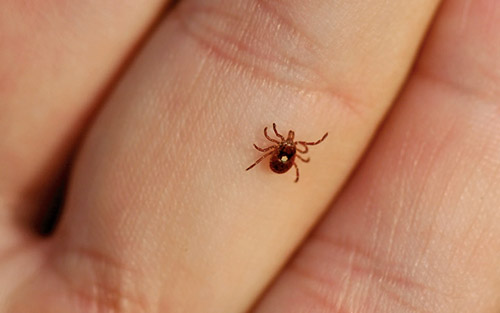
With the coming of summer, opportunities abound for our enjoyment of the great outdoors. However, as exciting as it is to hike in the woods or have a weekend camping trip, we should be mindful of the dangers of tick-borne infections, specifically Lyme disease. Lyme disease is especially prevalent in children in our area.
A Bit of Background
Lyme disease is caused by a corkscrew-shaped bacterium called Borrelia burgdorferi. This bacterium is carried by the deer or black-legged tick (also known as Ixodes scapularis). It is from the bite of an infected deer tick that we contract Lyme disease.
Deer ticks are tiny, with most being no larger than the period at the end of this sentence. Females and younger specimens called nymphs latch onto human hosts to drink blood for their sustenance.
Deer ticks usually wait in tall grasses and shrubs to latch on to their human victims and crawl up their bodies to find a safe spot to attach themselves. These ticks usually imbed themselves in areas where they would least likely be discovered, usually in the groin, armpits, within the hairline of the scalp and between folds of the skin.
Contrary to popular belief, deer ticks do not leap from overhanging branches to land on peoples’ heads. The head of a tick is armed with harpoon-like mouthparts to secure itself to its human host. It is during this time of attachment that the bacteria responsible for Lyme disease travel into human bodies.
What Are the Symptoms?
There are several signs of Lyme disease, the most prominent being a red bull’s-eye shaped rash that usually forms around the area of the tick bite. This rash (called erythema migrans) appears from two days to three weeks after the bite and is usually painless and non-itching.
Although this rash can confirm a diagnosis of Lyme disease, it appears in no more than 40% of infected children. Usually, children will get fevers, body aches, mild neck stiffness and headaches as manifestations of early Lyme disease. If your child has the bull’s-eye rash or the above symptoms, especially after finding a tick on him or her, it is important to see your pediatrician, as your child will need to be put on antibiotics for two to three weeks.
Precautions When Hiking
Avoiding ticks is nearly impossible when hiking through the woods, but several measures can decrease the likelihood of a bite.
Choosing light-colored clothes will help the detection of ticks crawling on your child. Wearing long pants, with pants legs tucked into your socks, will help keep ticks from crawling up bare legs. Usually, a tick needs to be attached for more than 24 hours to successfully transmit Lyme disease to a child or adult.
It is important to check your children for ticks every time they return from playing outside. Check especially hidden areas such as the armpits, groin and beyond the hairline in the scalp.
If you do find a tick embedded in your child, there is no need to panic. Most ticks can be removed with a simple set of fine tweezers. Firmly grasps the head of the tick, as close to the skin as possible and pull the tick upward from the skin.
Do not grab the body of the tick as this will force the tick to regurgitate its body contents into your child and increase the likelihood of getting Lyme disease. Do not use a lighter or fire to burn off a tick, as you will more likely burn your child. If the tick cannot be removed, it is wisest to call your pediatrician for help.
By Dr. Emmanuel Martakis
Dr. Emmanuel Martakis is a pediatrician at Tenafly Pediatrics.













